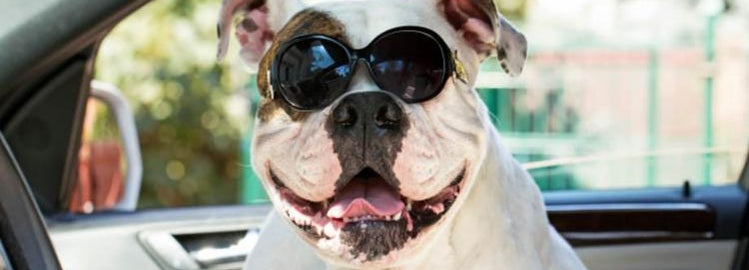Foolproof Tips for Road-Tripping with Pets

Is it normal to take pets on vacation? If you are anything like me, the answer is a resounding "Yes!" Years ago, I realized I missed my animals so much while traveling that on our next vacation we decided we’d take at least one with us. (We have five cats, two guinea pigs, and a bearded dragon.) Thus a family tradition of traveling with pets was born.
Just this summer we went away with our cat, Widget, and our bearded dragon, Gravos, which takes some doing considering there are also two teenage boys and a husband to get in the car. But as a family we've reached the perfect compromise--since there isn't enough room to fit us all in, my husband rides alongside on a motorcycle.
The Long History of Traveling with Pets
Our road trip was only about a hundred miles in each direction. That makes us amateurs compared to the epic journey made by Bud the Bulldog at the beginning of the 20th century. In 1903 Bud was "co-driver" of the first ever motor vehicle to travel coast to coast across the U.S. The car was an open-top Winton with a top speed of 30 mph. In an era when there were approximately 150 miles of paved road in the entire country, this epic trip took 63 days. There were no gas stations (the first gas station was established in 1905) and fuel had to be obtained along the way from general stores that kept a supply of gas for farm machinery.
The trip was the brainchild of Dr. Horatio Nelson Jackson. He did not set off with a dog, but rather acquired one along the way. The story goes that Jackson left his coat at a hotel, and realizing his mistake turned back to fetch it. On the road, he was stopped by a man asking if he wanted to buy a dog as a mascot. That dog was Bud, a light-colored bulldog, and Jackson, who had been thinking of getting a dog anyway, agreed for the princely sum of $15.
Bud soon took to his new life, especially once equipped with a pair of goggles to keep dust out of his eyes. He sat beside his new master on the passenger seat, staring intently at the road ahead, and quickly became adept at bracing himself against lumps and bumps on rocky tracks. Of course, there is no mention of seat belts or other safety devices, but then again I don't suppose they encountered many motor vehicles coming in the opposite direction on their journey.
Traveling with Pets Today
Travel has changed since Bud the Bulldog's epic road trip. These days it is essential to be safety conscious when traveling with animals. To make the trip stress-free for pets and humans alike, it is best to plan ahead. Here are some tips to help keep you and your pets happy and healthy along the way:
- Before setting off, make sure your pet is up-to-date with her vaccinations, and get her checked out by a vet. You don't want any nasty health surprises while in transit. If your pet takes medication, make sure you have enough for the entire trip, and also take a copy of her medical records along with you.
- Check with your vet about the risks posed by different regional disease threats, such as Lyme's disease, and what you can do to prevent them. Likewise, if your pet gets motion sickness, ask about one of the excellent non-drowsy anti-nausea medications that are available.
- Make sure the traveling animal is safely restrained, such as in a crash-tested crate for a dog, which provides a safety cocoon in the event of an accident. Likewise, never leave a cat loose in the car; always use a cat carrier or a pet seat harness. In the event of an emergency stop, an unrestrained cat becomes a high-speed missile that could seriously injure both herself and you.
- To keep an anxious pet calm and relaxed in transit, consider using one of the pheromone sprays designed to help calm dogs or cats. These are a synthetic version of the chemical that a nursing mother gives off that makes her puppies or kittens feel safe and secure. Simply spritz a favorite blanket with this nonprescription product to help reduce travel-induced anxiety.
- If you are planning a long trip, be sure to book pet-friendly accommodations or a campsite that welcomes animals (not all do). For everyone's comfort, stop at least every four hours and give the pet a chance to drink and stretch her legs. Of course it is essential that your pet's ID details be current, just in case your dog runs off and gets lost in unfamiliar surroundings.
Planning is the Key to Safe and Happy Travels with Your Pet
For peace of mind, make sure your pet insurance is up-to-date and provides adequate coverage. Pet insurance is about more than just health. You may want to check whether you are protected if the dog damages a hotel room or gets lost. Some policies cover the cost of a poster campaign to track down an errant dog or the expense of staying additional days in a hotel while you find her. Speak to a Trusted Choice® independent agent today to find out the options available to you, and ensure you can care for your pet under all circumstances.
